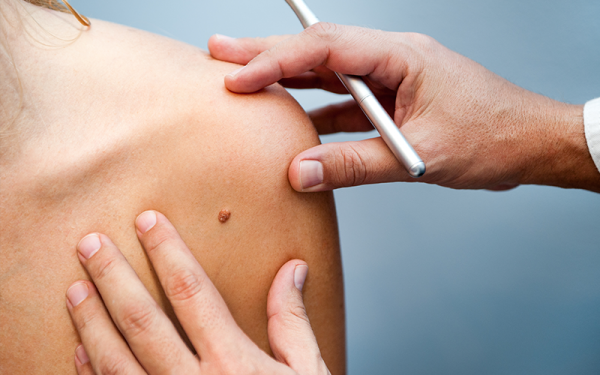There are many reasons to make Texas or the Midwest home for the outdoor enthusiast — golfing at any one of our amazing golf courses, cycling, hiking and watersports at our many gorgeous swimming holes and lakes.
We’re still enjoying our great outdoors well into the time when our northern friends start huddling up indoors. We get to enjoy our hobbies in our beautiful (mostly) temperate climate where we get a ton of sun exposure.
Along with sun exposure come risks for developing precancers and skin cancers. People with a lighter skin color and family history of skin cancer are especially at risk. If you have blonde hair and blue eyes, or if mom or dad had skin cancer, you have a higher risk of developing similar problems.
Skin cancers are often noticed as wounds that won’t heal over several months. For example, this may be attributed to a bump on the head, a spider bite, or an ingrown hair that just doesn’t go away.
Let’s go over some telltale signs of the most common types of non-melanoma skin cancer — basal cell carcinoma and squamous cell carcinoma — and ways to detect skin cancer early.
Basal Cell Carcinoma
Basal cell carcinoma (BCC) is the most common type of skin cancer. When comparing the severity of skin cancers, BCC is the least aggressive type. BCCs grow slowly and have the lowest chance of spreading elsewhere in the body. However, BCC is still skin cancer and can be locally destructive.
When BCCs are left to their own devices for several years, they can be really troublesome. For this reason, advanced BCCs have often been referred to as “rodent ulcers.” But with due diligence, it doesn’t have to get this far. Here are some signs to look out for.
BCC often starts as a new small pink or red spot or bump with a “pearly” appearance. BCCs most commonly occur on the face, but they can occur in really any area where someone has had sunburns or a lot of sun exposure, including the scalp, ears, neck, trunk, arms, and legs.
As a BCC gets larger on the surface, it also gets larger and spreads deeper into the skin. It may start to push on nerves within the skin, which will be painful at the site of the skin cancer. BCCs acquire extra blood vessels, which may start to ulcerate and bleed. As BCCs grow larger, their borders can take on a “heaped up” or rolled appearance as well.
Photo from the Skin Cancer Foundation
Squamous Cell Carcinoma
Squamous cell carcinomas (SCC) are more worrisome than basal cell carcinomas. This is because SCCs can grow more quickly and have a higher chance of spreading elsewhere in the body, or metastasizing. Additionally, SCCs can also be quite destructive if not treated in a timely manner. Again, with due diligence and early detection, things don’t have to get this far.
SCC often starts out as a new small red or pink bump. As compared to basal cell carcinomas, SCCs are more often scaly or crusted. Since SCCs are able to grow more quickly and invade elsewhere, they can become painful and prone to bleeding and ulceration.
Like BCCs, SCCs most commonly occur on the face, but they can occur in really any area where someone has had sunburns or a lot of sun exposure, including the scalp, ears, neck, trunk, arms and legs. SCCs can also occur on the lips and in the groin region.
This can be due to other factors in addition to sun exposure, including smoking (especially true for lip SCC) and infection with certain types of human papillomavirus (HPV), which can cause genital warts.
Photo from the Skin Cancer Foundation
When to See a Dermatologist
The general rule of skin cancers is that they do not improve with time; they continue to grow. You shouldn’t try to treat a suspicious mole, bump, or possible skin cancer on your own. If a growth on the skin looks concerning to your dermatologist, it will be biopsied to determine a diagnosis under the microscope.
Fortunately, not every spot on the skin that is worrisome turns out to be skin cancer.
Don’t let nerves keep you from getting a concerning spot-checked by a dermatologist. Consider that your nerves will be calmed if it is determined not to be skin cancer, and if it is indeed skin cancer, catching it early typically means that treatment will be easier for you.
Treatment Options
If the BCC or SCC is shallow enough in the skin, topical anti-cancer cream may be applied at the discretion of your dermatologist. If the BCC or SCC is invading deeper, your dermatologist may recommend excision, “scrape and burn,” or Mohs surgery for skin cancer.
The earlier that skin cancers are caught, the smaller the resulting scar from a procedure to remove the skin cancer will be.
Note that once you’ve had skin cancer, you’re at increased risk of developing new skin cancers because your skin has shown a predisposition to doing so. Regular follow up skin cancer screenings are important to catch new growths and treat them early. So, if you notice any new skin growth that is not healing, or is growing in size, painful, bleeding or ulcerated, contact your dermatologist.
We’ll be happy to help you so you can get back to enjoying outdoor activities — with sunscreen!
Looking to Visit a Dermatologist?
We have multiple locations throughout the country, so fill out our simple online form to get in touch with us. One of our local team members will reach out to you shortly to answer your questions or schedule an appointment for you to visit us soon.
Find a location near me
or



